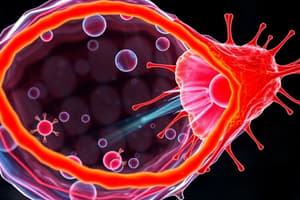Podcast
Questions and Answers
What happens to the cell when it is placed in a hypertonic solution?
What happens to the cell when it is placed in a hypertonic solution?
- It gains water and swells
- It loses water and shrinks (correct)
- It stays the same size
- It bursts and dies
What is the term for a solution that has the same concentration of water as the cell?
What is the term for a solution that has the same concentration of water as the cell?
- Isotonic solution (correct)
- Hypertonic solution
- Hypotonic solution
- Concentrated solution
What is the process by which water crosses the cell membrane from an area of high concentration to an area of low concentration?
What is the process by which water crosses the cell membrane from an area of high concentration to an area of low concentration?
- Passive transport
- Osmosis (correct)
- Active transport
- Diffusion
What is the function of the plasma membrane in relation to osmosis?
What is the function of the plasma membrane in relation to osmosis?
What happens to unicellular freshwater organisms when they are placed in water?
What happens to unicellular freshwater organisms when they are placed in water?
What is the term for the movement of molecules from an area of high concentration to an area of low concentration?
What is the term for the movement of molecules from an area of high concentration to an area of low concentration?
What is the role of osmosis in plant cells?
What is the role of osmosis in plant cells?
What is the composition of the plasma membrane?
What is the composition of the plasma membrane?
What is the purpose of adding a strong solution of sugar or salt to the mounted leaf on the slide?
What is the purpose of adding a strong solution of sugar or salt to the mounted leaf on the slide?
What is the function of chlorophyll in the cells?
What is the function of chlorophyll in the cells?
What is the purpose of boiling the Rhoeo leaves in water?
What is the purpose of boiling the Rhoeo leaves in water?
What is the material stuck on the ice-cream spoon when scraping the inside surface of the cheek?
What is the material stuck on the ice-cream spoon when scraping the inside surface of the cheek?
What is the purpose of adding methylene blue solution to the material on the slide?
What is the purpose of adding methylene blue solution to the material on the slide?
What is observed when a Rhoeo leaf is mounted in water and examined under a microscope?
What is observed when a Rhoeo leaf is mounted in water and examined under a microscope?
What happens to the cells when a strong solution of sugar or salt is added to the mounted leaf on the slide?
What happens to the cells when a strong solution of sugar or salt is added to the mounted leaf on the slide?
What is the shape of the cells observed under the microscope after boiling the Rhoeo leaves?
What is the shape of the cells observed under the microscope after boiling the Rhoeo leaves?
What is the main function of mitochondria in a cell?
What is the main function of mitochondria in a cell?
What happens if the organisation of a cell is destroyed?
What happens if the organisation of a cell is destroyed?
Why are lysosomes known as 'suicide bags'?
Why are lysosomes known as 'suicide bags'?
Where are proteins synthesised inside the cell?
Where are proteins synthesised inside the cell?
What is the function of chromoplasts in plant cells?
What is the function of chromoplasts in plant cells?
What is the internal organisation of a chloroplast composed of?
What is the internal organisation of a chloroplast composed of?
What is the function of leucoplasts in plant cells?
What is the function of leucoplasts in plant cells?
What is the basic structural and functional unit of life?
What is the basic structural and functional unit of life?
Which of the following structures is responsible for regulating the movement of materials between the cell's interior and its external environment?
Which of the following structures is responsible for regulating the movement of materials between the cell's interior and its external environment?
What is the primary function of leucoplasts in plant cells?
What is the primary function of leucoplasts in plant cells?
Which of the following is NOT a function of the Golgi apparatus?
Which of the following is NOT a function of the Golgi apparatus?
What is the main component of the cell wall in plants?
What is the main component of the cell wall in plants?
Which type of plastid is responsible for photosynthesis?
Which type of plastid is responsible for photosynthesis?
What is the role of the nucleus in a eukaryotic cell?
What is the role of the nucleus in a eukaryotic cell?
Which of the following organisms has a cell wall?
Which of the following organisms has a cell wall?
What is the significance of the cell wall in preventing plant cells from bursting in hypotonic media?
What is the significance of the cell wall in preventing plant cells from bursting in hypotonic media?
Why does water gather in the hollowed portion of cup B?
Why does water gather in the hollowed portion of cup B?
What is the function of potato A in this experiment?
What is the function of potato A in this experiment?
Why does water not gather in the hollowed portions of cups A and D?
Why does water not gather in the hollowed portions of cups A and D?
Which type of cell division is essential for growth and repair of the body?
Which type of cell division is essential for growth and repair of the body?
Which type of cell division is involved in the formation of gametes?
Which type of cell division is involved in the formation of gametes?
What is most likely to happen if potato D contains salt instead of sugar?
What is most likely to happen if potato D contains salt instead of sugar?
Flashcards are hidden until you start studying
Study Notes
Osmosis
- Osmosis is the movement of water into or out of a cell due to a concentration gradient.
- If a cell is placed in a concentrated solution (hypertonic), it will lose water and shrink.
- If a cell is placed in a dilute solution (hypotonic), it will gain water and swell.
- If a cell is placed in a solution with the same concentration as the cell (isotonic), there will be no net movement of water.
Cell Structure
- The cell membrane is flexible and made up of organic molecules called lipids and proteins.
- The plasma membrane is an active part of the cell, regulating the movement of materials between the cell and its environment.
Plastids
- Plastids are present only in plant cells.
- There are two types of plastids: chromoplasts (coloured) and leucoplasts (white or colorless).
- Chloroplasts are a type of chromoplast that contains chlorophyll and are important for photosynthesis.
- Leucoplasts primarily store materials such as starch, oils, and protein granules.
Cell Organization
- The fundamental organizational unit of life is the cell.
- Cells have a basic structural organization, with the cell membrane, cytoplasm, and organelles working together to perform functions like respiration, obtaining nutrition, and clearing waste material.
- The cell is the fundamental structural and functional unit of living organisms.
Mitochondria
- Mitochondria are organelles that have their own DNA and ribosomes, allowing them to make some of their own proteins.
- Mitochondria use energy stored in ATP for making new chemical compounds and for mechanical work.
Lysosomes
- Lysosomes are known as "suicide bags" because they contain digestive enzymes that can break down and recycle cellular waste and foreign substances.
Cell Division
- There are two types of cell division: mitosis (for growth and repair of body) and meiosis (for formation of gametes).
Studying That Suits You
Use AI to generate personalized quizzes and flashcards to suit your learning preferences.





